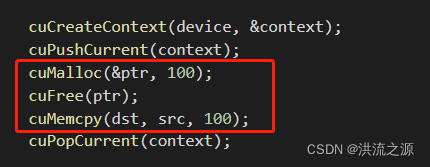CUDA中的上下文context是为了方便控制device而提出的,而context通过栈进行管理:
- context是一种上下文,关联对GPU的所有操作,context与一块显卡关联,一个显卡可以被多个context关联;
- 每个线程都有一个栈结构储存context,栈顶是当前使用的context,对应有push、pop函数操作context的栈,所有api都以当前context为操作目标;
cuCreateContext、cuPushCurrent、cuPopCurrent函数实现context的创建、压栈、出栈操作 ,如下:

注意:cuCreateContext在创建context的同时会自动进行压栈的操作
由于高频操作,一个线程基本固定访问一个显卡不变,且只使用一个context,很少会用到多context,cuCreateContext、cuPushCurrent、cuPopCurrent这种多context管理就显得麻烦,因此推出了cuDevicePrimaryCtxRetain,为设备关联主context,分配、释放、设置、栈自动完成,此时一个显卡对应一个context ,不同线程,只要设备id一样,?context就一样,此时的context也是线程安全的,如下:

?示例代码:
// CUDA驱动头文件cuda.h
#include <cuda.h>
#include <stdio.h>
#include <string.h>
#define checkDriver(op) __check_cuda_driver((op), #op, __FILE__, __LINE__)
bool __check_cuda_driver(CUresult code, const char* op, const char* file, int line){
if(code != CUresult::CUDA_SUCCESS){ // 如果 成功获取CUDA情况下的返回值 与我们给定的值(0)不相等, 即条件成立, 返回值为flase
const char* err_name = nullptr; // 定义了一个字符串常量的空指针
const char* err_message = nullptr;
cuGetErrorName(code, &err_name);
cuGetErrorString(code, &err_message);
printf("%s:%d %s failed. \n code = %s, message = %s\n", file, line, op, err_name, err_message); //打印错误信息
return false;
}
return true;
}
int main(){
// 检查cuda driver的初始化
checkDriver(cuInit(0));
// 为设备创建上下文
CUcontext ctxA = nullptr; // CUcontext 其实是 struct CUctx_st*(是一个指向结构体CUctx_st的指针)
CUcontext ctxB = nullptr;
CUdevice device = 0;
checkDriver(cuCtxCreate(&ctxA, CU_CTX_SCHED_AUTO, device)); // 这一步相当于告知要某一块设备上的某块地方创建 ctxA 管理数据。输入参数 参考 https://www.cs.cmu.edu/afs/cs/academic/class/15668-s11/www/cuda-doc/html/group__CUDA__CTX_g65dc0012348bc84810e2103a40d8e2cf.html
checkDriver(cuCtxCreate(&ctxB, CU_CTX_SCHED_AUTO, device));
printf("ctxA = %p\n", ctxA);
printf("ctxB = %p\n", ctxB);
/*
contexts 栈:
ctxB -- top <--- current_context
ctxA
...
*/
// 获取当前上下文信息
CUcontext current_context = nullptr;
checkDriver(cuCtxGetCurrent(¤t_context)); // 这个时候current_context 就是上面创建的context
printf("current_context = %p\n", current_context);
// 可以使用上下文堆栈对设备管理多个上下文
// 压入当前context
checkDriver(cuCtxPushCurrent(ctxA)); // 将这个 ctxA 压入CPU调用的thread上。专门用一个thread以栈的方式来管理多个contexts的切换
checkDriver(cuCtxGetCurrent(¤t_context)); // 获取current_context (即栈顶的context)
printf("after pushing, current_context = %p\n", current_context);
/*
contexts 栈:
ctxA -- top <--- current_context
ctxB
...
*/
// 弹出当前context
CUcontext popped_ctx = nullptr;
checkDriver(cuCtxPopCurrent(&popped_ctx)); // 将当前的context pop掉,并用popped_ctx承接它pop出来的context
checkDriver(cuCtxGetCurrent(¤t_context)); // 获取current_context(栈顶的)
printf("after poping, popped_ctx = %p\n", popped_ctx); // 弹出的是ctxA
printf("after poping, current_context = %p\n", current_context); // current_context是ctxB
checkDriver(cuCtxDestroy(ctxA));
checkDriver(cuCtxDestroy(ctxB));
// 更推荐使用cuDevicePrimaryCtxRetain获取与设备关联的context
// 注意这个重点,以后的runtime也是基于此, 自动为设备只关联一个context
checkDriver(cuDevicePrimaryCtxRetain(&ctxA, device)); // 在 device 上指定一个新地址对ctxA进行管理
printf("ctxA = %p\n", ctxA);
checkDriver(cuDevicePrimaryCtxRelease(device));
return 0;
}